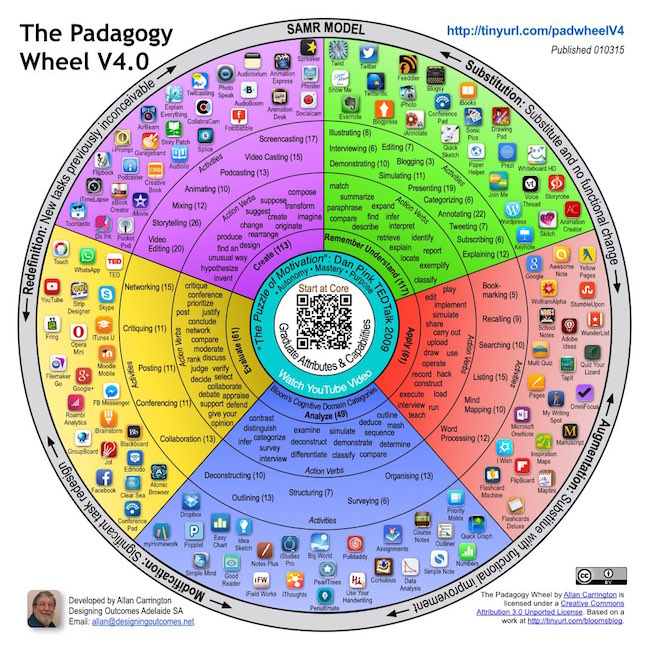
 DOWNLOAD THE LATEST VERSION: V4 published Mar 2015. This PDF Poster has links to 122 of the latest and most popular educational apps. Now these resources are available in 19 different languages. The poster also has app selection criteria according to Blooms taxonomy. It could provide the backbone of a complete course or seminar on Learning Design. If you would like help with this please just ask. It also prints well as an A3 poster. With QR Codes linking to more online resources. You are also encouraged to print it out for use in your college or school.
DOWNLOAD THE LATEST VERSION: V4 published Mar 2015. This PDF Poster has links to 122 of the latest and most popular educational apps. Now these resources are available in 19 different languages. The poster also has app selection criteria according to Blooms taxonomy. It could provide the backbone of a complete course or seminar on Learning Design. If you would like help with this please just ask. It also prints well as an A3 poster. With QR Codes linking to more online resources. You are also encouraged to print it out for use in your college or school.
I am still a little numb at the amazing interest in, and discussion about, the Padagogy Wheel from teachers and educators around the world. It is only a week since I published my last blog post “The Padagogy Wheel V2.0: It’s all about transformation and integration“. and the poster is at 8000 downloads and 500-800 people visit the blog a day and about 300 tweets a day as well.. I owe a sincere thank you to Jeff Dunn and the team at Edudemic for the encouraging first article “Integrate iPads Into Bloom’s Digital Taxonomy With This ‘Padagogy Wheel’” then the second blog post “New Padagogy Wheel Helps You Integrate Technology Using SAMR Model” The second article really did whip up an interest storm. I think you will appreciate the posts.
So why yet another version only one week later? Well out of the buzz about V2.0 came a suggestion that I couldn’t lay down, it ran around my head for days. A good friend said, “You know motivation is also at the core of the Wheel … how would that work?” Add to this line of thinking the fact that it seems all the excitement is about how Blooms interacts with the SAMR model and no one seems to be talking about the core of the wheel – Graduate Attributes and Capabilities. I wanted to upgrade the communication about the core concepts of the wheel so nobody missed their importance.
 Graduate Attributes and Capabilities: Without this your learning design will drift. A major ah aha for me was when Prof Geoff Scott, the Executive Director of Sustainability at University of Western Sydney (UWS), was introduced as a keynote speaker at a Learning and Teaching Conference at the University of Adelaide in 2012. It was in during that presentation Geoff introduced research they had done within the business sector. They had asked CEO’s and executives …. the people that do the hiring, what they desired to see in graduates from Higher Education programs. When he introduced us to the top 15 requested capabilities, there was almost an audible gasp. Most of these are heart attitudes and values based. There was even more exclamation when we realised that most of them were not actively targeted by our courses. The top 15 are
Graduate Attributes and Capabilities: Without this your learning design will drift. A major ah aha for me was when Prof Geoff Scott, the Executive Director of Sustainability at University of Western Sydney (UWS), was introduced as a keynote speaker at a Learning and Teaching Conference at the University of Adelaide in 2012. It was in during that presentation Geoff introduced research they had done within the business sector. They had asked CEO’s and executives …. the people that do the hiring, what they desired to see in graduates from Higher Education programs. When he introduced us to the top 15 requested capabilities, there was almost an audible gasp. Most of these are heart attitudes and values based. There was even more exclamation when we realised that most of them were not actively targeted by our courses. The top 15 are
- Having energy, passion and enthusiasm
- Being willing to give credit to others
- Empathising & working productively with diversity
- Being transparent and honest in dealings with others
- Thinking laterally and creatively
- Being true to one’s values and ethics
- Listening to different points of view before coming to a decision
- Understanding personal strengths & limitations
- Time management skills
- Persevering
- Learning from errors
- Learning from experience
- Remaining calm when under pressure
- Being able to make effective presentations to different groups
- Identifying from a mass of information the core issue/opportunity
These capabilities should be identified as part of our graduate attributes and woven into the fabric of our courses in the activity design. We need to have transformation at the core of what we do as teachers if it is all about the students. Don’t jump into learning outcomes, activity design and choosing technology without first reflecting on graduate attributes and capabilities then how to improve motivation and engagement. Skip these and your course design will be weaker for it.
Please visit the blog post and listen to the podcast episode at: “If you exercise these capabilities.. you will be employed!”
The Puzzle of Motivation: Teachers use the term engagement all the time. Engagement is about motivation. If students are not motivated learning will not happen. As I researched about motivation I discovered this TEDtalk …. of course 2.5 million others knew about it first, which naturally raised my interest. As I watched it, lights went on big time. “Ah Aha! These concepts are a grid to help people improve learning activity design and they have to go into the wheel” – V3.0 was born.
Dan Pink shows what science knows about motivation and what business does about it are largely mismatched. He presents a very strong case for a rethink about motivation in business and offers a new approach and model for the 21st century. It is built around intrinsic motivations. He introduces the elements which he says are the building blocks of a completely new operating system for businesses.
- AUTONOMY: The urge to direct our own lives
- MASTERY: The desire to get better and better at something that matters
- PURPOSE: The yearning to do what we do in the service of something larger than ourselves
Dan expands on the concept of Autonomy.and introduces examples of three levels of application of this type of motivation. “Fedex Days” where staff have to deliver outcomes overnight then “The 20 Percent time” … done famously at Google. Finally the “Results Only Work Environment or ROWE” where he compares the motivation and implementation for two models of encyclopedia i.e. Encarta and Wikipedia.
Please watch this video and think about how you build curriculum, how to facilitate your courses and how to motivate tomorrows students to become all they can be as leaders that make a difference. Could this model of motivation change the way we build curriculum and teach courses – I believe used as part of the Padagogy Wheel it will go a long way in the hands of passionate teachers. Please post your comments and suggestions for new apps.


A very interesting post in Allan Carrington's blog.
Thanks Phil I know this model can help everyone who is a teacher. I am still trying to get my head around that as at AM Thu 060623 Australian time, the PDF file of the Poster of the Padagogy Wheel had been downloaded 14,800 times in a month. 800 times since Monday (4 days) I am comfortable with claiming the model has reached 50,000 teachers around the world and still going. I owe a lot to the review in Edudemic http://bit.ly/138FtJj
This is the first time I have seen this wheel. I think that this will be very helpful in helping all digital immigrants learn how technology can work within and expand upon what they already do in their classrooms. I plan to share this with the teachers at my school and I plan to use it as well. Thanks for all of your hard work in creating it. I am planning to take some in depth time with it and look into all of the apps listed. Exciting! Also does anyone know a good blog for apps? I am endlessly searching, but with limited time to test apps due to the hectic pace of teaching I am looking for good advice.
Pingback: The Padagogy Wheel V3.0 | Getting Started With ...
The wheel is fantastic, thank you for giving us the opportunity to use it with our students!
Pingback: Allan's Blog | iPads in Education | Scoop.it
Pingback: The Padagogy Wheel V3.0: Learning Design starts...
Pingback: Allan's Blog | Tools to Prepare the 21st Centur...
Pingback: Allan's Blog | Teaching and testing | Scoop.it
Pingback: Allan's Blog | PBL | Scoop.it
Pingback: App Suggestions for Learning Activities in BYOD Classrooms | Making things... Learning Things
Pingback: Planning Learning Experiences | ictlearningjourney
Pingback: Bloom Taxonomy | Fun Learning in ICT
Pingback: Learning and Teaching Blog | Library instructio...
Pingback: Learning and Teaching Blog | Technolicious | Sc...
Pingback: The Padagogy Wheel V3.0: Learning Design starts...
Pingback: Allan's Blog | eBookED | Scoop.it
Pingback: Allan's Blog | personalised learning | Scoop.it
Pingback: A Library Student at MLA ’14 – Pacing Myself |
Thank you, this is such a great model1 Do you mind if I share?
Pingback: Allan's Blog | iPads, Apps, Innovation, and Edu...
Pingback: Padagogy Wheel Ver 3.0 | Digital learning. | S...
Pingback: Allan's Blog | 21st Century School Libraries | ...
Pingback: Module 2 and Understanding It! | Brooke McEwan
Pingback: Part 3… Beyond the Technology Shine… Content Standard Verbs and Blended Learning Possiblities | 21 st Century Educational Technology and Learning
Pingback: Part 1…Beyond the Shine : Supporting Technology with the SAMR Model plus Ten Great Resource Sites | 21 st Century Educational Technology and Learning
Pingback: The Padagogy Wheel: ένας οδηγός ενσωμάτωσης της τεχνολογίας στην εκπαίδευση. | EdTech.gr
Allan Carrington Dear Allan, do you think the poster also works fine for conferences etc.? Or do you have "another" poster for events like that? Best regards from Germany. Stefan
Stefan Braun Mate use the download link above and it is a PDF which can be printed A3 if needed .. hope that helps. BTW the downlaods are now in excess of 150,000 and if you see the top of my blog here you will see I am publishing the Padagogy Wheel in 20 languages … German is out (see blog) Enjoy! 🙂
Pingback: The Padagogy Wheel: ένας οδηγός ενσωμάτωσης της τεχνολογίας στην εκπαίδευση. | EdTech.gr
Pingback: DIGITAL FLUENCY – TEACHING AND LEARNING IN THE DIGITAL WORLD
Pingback: Computational thinking and collaboration – ElizabethYoungDigitalEd